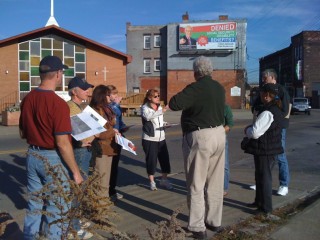Read the start of this article below; to view full article you need to be a PlannersWeb member. Already a member? — be sure you’re logged-in. Not a member? Consider joining the PlannersWeb.
One pleasant sunny day, we decided to walk rather than drive to our favorite local eatery for a bite of lunch. Though we walked the same route that we normally drove, we were both astounded at all the neighborhood details we noticed because we were on foot and not inside the car.
- Perhaps it is because a walking pace gives you time to actually see and absorb the details of your surroundings.
- Perhaps it is about being on the sidewalk within arms’ reach of the neighborhood’s textures and colors rather than being insulated from the environment by steel and plastic and glass.
- Perhaps car travel requires so much of our attention to the road and surrounding traffic that we just don’t have sufficient attention remaining to absorb the rich details of the places we think we know because we drive through them every day.
Perhaps it is all those reasons. But what our walk did was reaffirmed us of the importance of taking a “walkabout approach” to public meetings (and to discovering a new bakery or sandwich shop along the way!).

Gaining New Perspectives
Jim has long been a champion of walkabouts, and has done them in community planning processes from Logansport, Indiana and Blawnox, Pennsylvania, to Napier, New Zealand. Something magical happens when planning commissioners walk their communities with citizens, business owners, and elected officials. Like our recent walk through our neighborhood, the level of community detail people discover on foot is exponentially greater that what they thought they knew about their place.

Walkabouts also promote a creative view of what those ignored and worn-out spaces that every community has can become. On a recent River Towns Walkabout — for the communities that are part of the pilot Allegheny County, Pennsylvania River Towns project — that Jim led, residents of Sharpsburg suddenly saw an underused industrial area as a potential new gateway (see photo on right), while citizens in Aspinwall found that a soul-less alley was actually an ideal location for a landscaped pedestrian arcade (see photo at start of article).
Walking The Sites
Walkabouts have a variety of applications: from being a part of a public participation process to being an integral piece of a formal meeting or information session to being a site visit for a specific project.
Why are walkabouts so useful?
… to read the rest of the article you need to be a PlannersWeb.com member. If you’re already a member, be sure you’re logged in (use the box in the upper right-hand corner of the page).
Jim Segedy, FAICP, worked for many years in Ball State University’s Community Based Planning program, providing assistance to more than one hundred communities and many plan commissions (as planning commissions are called in Indiana). He is currently a member of the Edgewood (Pennsylvania) Planning Commission and previously served on the Delaware County (Indiana) Plan Commission.
Lisa Hollingsworth-Segedy, AICP, is the Associate Director for River Restoration for American Rivers’ Pittsburgh field office. Before moving to Pennsylvania, she spent over a decade as a circuit-riding planner for a regional planning organization serving the western fringe of Metropolitan Atlanta.
You must be logged in or a PlannersWeb member to read the rest of the article.